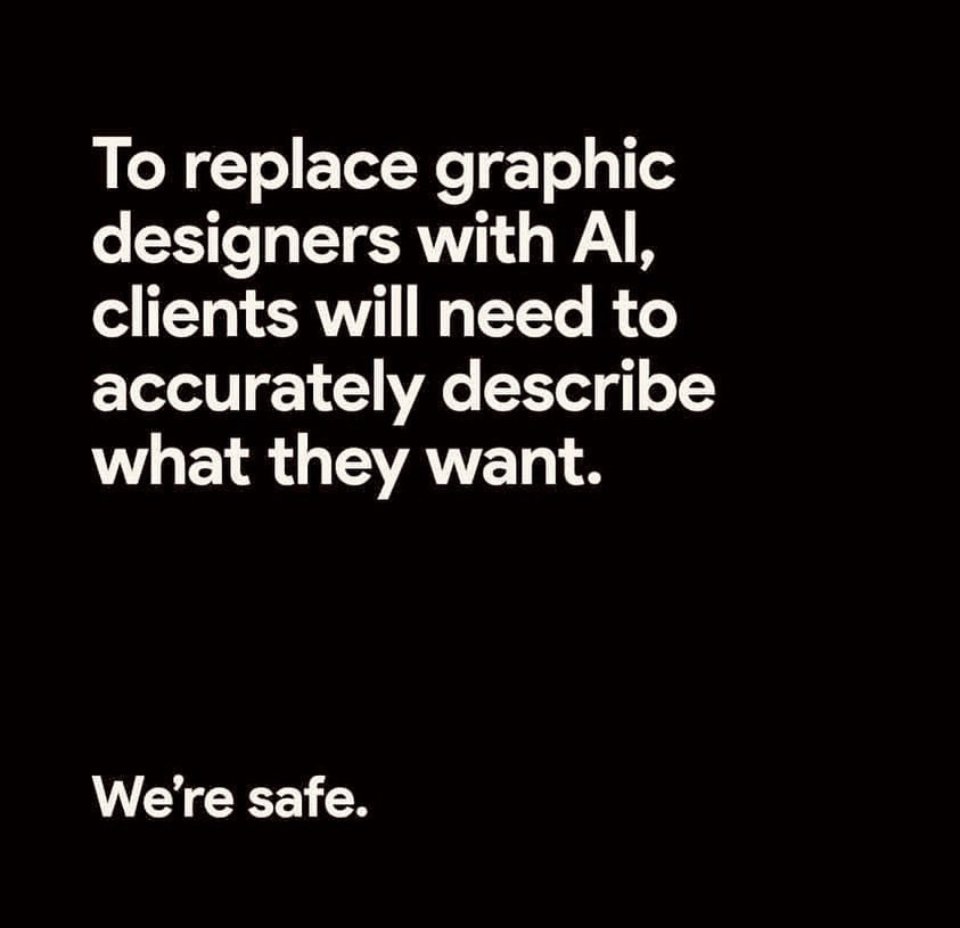We’re safe.
Image credit @designershumor
In all seriousness. The advent of AI has undoubtedly revolutionized many sectors, rendering processes faster and more efficient and reducing human error. It's profoundly impacted areas like healthcare, transportation, and even creative industries, with some suggesting that AI could replace jobs in the graphic design field. However, this perspective underestimates the unique qualities that human graphic designers bring to the table. While AI may augment and assist in the process, it will not replace human designers, and here's why:
The Necessity of Human Creativity:
AI can mimic creativity by learning patterns, but it cannot originate creativity. Graphic design is not just about creating visually appealing content; it involves communicating a story, a message, or an emotion. Human designers bring a level of creativity, originality, and intuition that AI currently cannot replicate. Graphic designers draw from their personal experiences, cultural backgrounds, and emotional depths to create unique designs that resonate with audiences on a human level.
Understanding Context:
AI cannot fully understand the context. It can analyze data and find patterns, but human understanding is required to interpret the more profound meaning, nuances, and cultural sensitivities. Graphic designers must have a firm grasp of the target audience's psyche, which AI can assist with but can only partially undertake. Specific colors, symbols, or design elements may be appropriate in one context but offensive in another, a subtlety that AI cannot yet discern.
Ethical Considerations:
Ethics plays a significant role in graphic design. Decisions about inclusivity, representation, and messaging often need to be made, which require a solid ethical compass. These decisions are influenced by societal norms, cultural values, and personal beliefs, all areas where AI falls short. Designers are responsible for ensuring their work doesn't perpetuate harmful stereotypes or misinformation - a task that requires a human touch.
The Need for Adaptability:
The graphic design landscape is continuously evolving, with trends coming and going. While AI can be programmed to follow the latest trends, the ability to predict and set trends comes from a human designer's ability to adapt and innovate. Moreover, designers can adjust their approach based on client feedback, which AI cannot replicate to the same degree.
Emotional Intelligence:
Emotional intelligence in design is about the ability to evoke specific emotions, empathize with the audience, and create a meaningful connection. This requires understanding human psychology and the subtle ways design elements can influence emotion. AI may identify patterns in emotional responses, but the ability to understand and intuitively implement these elements in design is a uniquely human trait.
Conclusion:
While AI is a powerful tool that can enhance graphic design, it is not a replacement for human designers. The creativity, contextual understanding, ethical judgment, adaptability, and emotional intelligence of humans are aspects that AI cannot fully embody. Instead of replacing designers, AI should be viewed as a tool that can streamline processes, perform repetitive tasks, and provide valuable data analysis, freeing designers to focus on their work's creative and nuanced aspects. This collaborative approach between AI and human designers holds the key to the future of graphic design.

